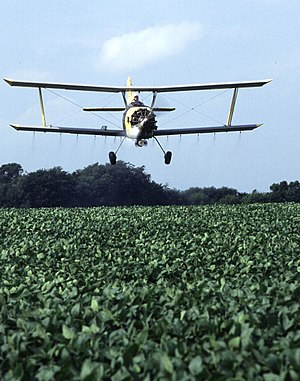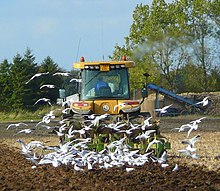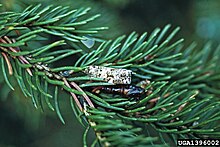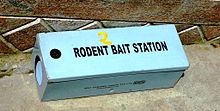Pest control: Difference between revisions
Cwmhiraeth (talk | contribs) →Sterilization: Adding further information |
Cwmhiraeth (talk | contribs) →Sterilization: Adding further information |
||
| Line 90: | Line 90: | ||
===Sterilization=== |
===Sterilization=== |
||
Populations of pest insects can sometimes be dramatically reduced by the release of sterile individuals. This involves the mass rearing of a pest, sterilising it by means of X-rays or some other means, and releasing it into a wild population. It is particularly useful where a female only mates once and where the insect does not disperse widely.<ref>{{cite book|author=Thacker, J.R.M.|title=An Introduction to Arthropod Pest Control|url=https://books.google.com/books?id=jN7lCC_BaG4C&pg=PA193 |year=2002|publisher=Cambridge University Press|isbn=978-0-521-56787-9 |page=193}}</ref> |
Populations of pest insects can sometimes be dramatically reduced by the release of sterile individuals. This involves the mass rearing of a pest, sterilising it by means of X-rays or some other means, and releasing it into a wild population. It is particularly useful where a female only mates once and where the insect does not disperse widely.<ref>{{cite book|author=Thacker, J.R.M.|title=An Introduction to Arthropod Pest Control|url=https://books.google.com/books?id=jN7lCC_BaG4C&pg=PA193 |year=2002|publisher=Cambridge University Press|isbn=978-0-521-56787-9 |page=193}}</ref> This technique has been successfully used agiainst the [[Cochliomyia hominivorax|New World screw-worm fly]], some species of [[tsetse fly]], tropical [[Drosophilidae|fruit flies]], the [[pink bollworm]] and the [[codling moth]], among others.<ref>{{cite book|author1=Dyck, V.A.|author2=Hendrichs, J.|author3=Robinson, A.S.|title=Sterile Insect Technique: Principles and Practice in Area-Wide Integrated Pest Management|url=https://books.google.com/books?id=-vOLhFewchoC&pg=PA4 |year=2006 |publisher=Springer Science & Business Media|isbn=978-1-4020-4051-1 |page=4}}</ref> |
||
Laboratory studies conducted with U-5897 (3-chloro-1,2-propanediol) were attempted in the early 1970s for rat control, although these proved unsuccessful.<ref name=sterile>{{cite journal |author=Bowerman, Alan M.; Brooks, Joe E. |year=1971 |title=Evaluation of U-5897 as a male chemosterilant for rat control |journal=[[Journal of Wildlife Management]] |volume=35 |issue=4 |pages=618–624 |jstor=3799765 |doi=10.2307/3799765}}</ref> In 2013, New York City tested sterilization traps,<ref name=Swartz2014>{{cite news|author1=Tracy Swartz|title=CTA to put rats on birth control|url=http://www.redeyechicago.com/news/cta/redeye-cta-to-put-rats-on-birth-control-20141222,0,451858.story|accessdate=10 January 2015|agency=Chicago Tribune|date=22 Dec 2014}}</ref> demonstrating a 43% reduction in rat populations.<ref name=Swartz2014 /> The product [[ContraPest]] was approved for the sterilization of rodents by the [[United States Environmental Protection Agency]] in August 2016.<ref>{{cite web |url=http://www.pctonline.com/article/senestech-contrapest-rodent-product-epa-approval/ |publisher=Pest Control Technology, GIA Media |title=ContraPest Rodent Control Product Wins EPA Approval |date=12 August 2016 |access-date=11 November 2016}}</ref> |
Laboratory studies conducted with U-5897 (3-chloro-1,2-propanediol) were attempted in the early 1970s for rat control, although these proved unsuccessful.<ref name=sterile>{{cite journal |author=Bowerman, Alan M.; Brooks, Joe E. |year=1971 |title=Evaluation of U-5897 as a male chemosterilant for rat control |journal=[[Journal of Wildlife Management]] |volume=35 |issue=4 |pages=618–624 |jstor=3799765 |doi=10.2307/3799765}}</ref> In 2013, New York City tested sterilization traps,<ref name=Swartz2014>{{cite news|author1=Tracy Swartz|title=CTA to put rats on birth control|url=http://www.redeyechicago.com/news/cta/redeye-cta-to-put-rats-on-birth-control-20141222,0,451858.story|accessdate=10 January 2015|agency=Chicago Tribune|date=22 Dec 2014}}</ref> demonstrating a 43% reduction in rat populations.<ref name=Swartz2014 /> The product [[ContraPest]] was approved for the sterilization of rodents by the [[United States Environmental Protection Agency]] in August 2016.<ref>{{cite web |url=http://www.pctonline.com/article/senestech-contrapest-rodent-product-epa-approval/ |publisher=Pest Control Technology, GIA Media |title=ContraPest Rodent Control Product Wins EPA Approval |date=12 August 2016 |access-date=11 November 2016}}</ref> |
||
Revision as of 11:23, 29 August 2017

Pest control is the regulation or management of a species defined as a pest, a member of the animal kingdom that impacts adversely on human activities. The human response depends on the importance of the damage done, and will range from tolerance, through deterrence and management, to attempts to completely eradicate the pest. Methods used for control include mechanical, chemical and biological means and may be performed as part of an integrated pest management strategy.
History

Pest control is at least as old as agriculture, as there has always been a need to keep crops free from pests. As long ago as 3000 BC in Egypt, cats were used to control pests of grain stores such as rodents.[1][2] Ferrets were domesticated by 500 AD in Europe for use as mousers. Mongooses were introduced into homes to control rodents and snakes, probably by the ancient Egyptians.[3]
The conventional approach was probably the first to be employed, since it is comparatively easy to destroy weeds by burning them or plowing them under, and to kill larger competing herbivores. Techniques such as crop rotation, companion planting (also known as intercropping or mixed cropping), and the selective breeding of pest-resistant cultivars have a long history.

Chemical pesticides were first used around 2500 BC, when the Sumerians used sulphur compounds as insecticides. Biological control is first recorded around 300 AD in China, where colonies of weaver ants, Oecophylla smaragdina, were intentionally plated in citrus plantations to control beetles and caterpillars.[4]
It was only with the industrialization and mechanization of agriculture in the 18th and 19th century, and the introduction of the insecticides pyrethrum and derris that chemical pest control became widespread. In the 20th century, the discovery of several synthetic insecticides, such as DDT, and herbicides boosted this development. Chemical pest control is still the predominant type of pest control today, although its long-term effects led to a renewed interest in traditional and biological pest control towards the end of the 20th century.
In agriculture, horticulture and forestry
Biological pest control

Biological pest control is a method of controlling pests such as insects and mites by using other organisms.[5] It relies on predation, parasitism, herbivory or other natural mechanisms, but typically also involves an active human management role. Classical biological control involves the introduction of natural enemies of the pest that are bred in the laboratory and released into the environment. An alternative approach is to augment the natural enemies that occur in a particular area by releasing more, either in small, repeated batches, or in a single large-scale release. Ideally, the released organism will breed and survive, and provide long-term control.[6] Biological control can be an important component of an integrated pest management programme.
For example: mosquitoes are often controlled by putting Bt Bacillus thuringiensis ssp. israelensis, a bacterium that infects and kills mosquito larvae, in local water sources.[7]
Cultural control

Mechanical pest control is the use of hands-on techniques as well as simple equipment and devices, that provides a protective barrier between plants and insects. This is referred to as tillage and is one of the oldest methods of weed control as well as being useful for pest control; wireworms, the larvae of the common click beetle, are very destructive pests of newly ploughed grassland, and repeated cultivation exposes them to the birds and other predators that feed on them.[8]
Crop rotation can help to control pests by depriving them of their host plants. It is a major tactic in the control of corn rootworm, and has reduced early season incidence of Colorado potato beetle by as much as 95%.[9]
Trap cropping
A trap crop is a crop of a plant that attracts pests, diverting them from nearby crops.[10] Pests aggregated on the trap crop can be more easily controlled using pesticides or other methods.[11] However, trap-cropping, on its own, has often failed to cost effectively reduce pest densities on large commercial scales, without the use of pesticides, possibly due to the pests' ability to disperse back into the main field.[11]
Chemical

Pesticides are applied to crops by agricultural aircraft, tractor-mounted crop sprayers or as seed dressings to control pests. However, successful control by pesticides is not easy; the right formulation must be chosen, the timing is often critical, the method of application is important, adequate coverage and retention on the crop are necessary. The killing of natural enemies of the target pest should be minimised. This is particularly important in countries where there are natural reservoirs of pests and their enemies in the countryside surrounding plantation crops, and these co-exist in a delicate balance. Often in less-developed countries, the crops are well adapted to the local situation and no pesticides are needed. Where progressive farmers are using fertilisers to grow improved crop varieties, these are often more susceptible to pest damage, but the indiscriminate application of pesticides may be detrimental in the longer term.[12]
Pesticides are formulated to kill pests, but many have detrimental effects on non-target species. Of particular concern are honey-bees, solitary bees and other pollinating insects. The time of day when the spray is applied can be important. The widely-used neonicotinoids have been banned on flowering crops in some countries because of their effects on bees.[13] Some pesticides may cause cancer and other health problems in humans, as well as being harmful to wildlife.[14] There can be acute effects immediately after exposure or chronic effects after continuous low-level, or occasional exposure.[15] Maximum residue limits for pesticides in foodstuffs and animal feed are set by many nations.[16]

Forestry
Forest pests present a significant problem because it is not easy to access the canopy and monitor pest populations. Pheromone traps have been used for this purpose. These release volatile chemicals that attract males. Pheromone traps can detect the arrival of pests or alert foresters to outbreaks. Traps of this sort have been used to monitor spruce budworm in Canadian forests for several decades.[17]
Forestry pests such as bark beetles, kept under control by natural enemies in their native range, may be transported large distances in cut timber to places where they have no natural predators, enabling them to cause extensive economic damage.[18]
In homes and cities
Many unwelcome creatures visit or make their home in residential buildings, industrial sites and urban areas. Some contaminate foodstuffs, damage structural timbers, chew through fabrics or infest stored dry goods. Some inflict great economic loss, others carry diseases or cause fire hazards, and some are just a nuisance. Control of these pests has been attempted by improving sanitation and garbage control, modifying the habitat, and using repellents, growth regulators, traps, baits and pesticides.[19]
Physical pest control

Physical pest control involves trapping or killing pests such as insects and rodents. Historically, local people or paid rat-catchers caught and killed rodents using dogs and traps.[20] On a domestic scale, sticky flypapers are used to trap flies. In larger buildings, insects may be trapped using such means as pheromones, synthetic volatile chemicals or ultraviolet light to attract the insects; some have a sticky base or an electrically charged grid to kill them. Glueboards are sometimes used for monitoring cockroaches and to catch rodents. Rodents can be killed by suitably baited spring traps and can be caught in cage traps for relocation. Talcum powder or "tracking powder" can be used to establish routes used by rodents inside buildings and acoustic devices can be used for detecting termites in structural timbers.[19]
Poisoned bait

Poisoned bait is a common method for controlling rats, mice, birds, slugs, snails, ants, cockroaches and other pests. The basic granules, or other formulation, contains a food attractant for the target species and a suitable poison. For ants, a slow-acting toxin is needed so that the workers have time to carry the substance back to the colony, and for flies, a quick-acting substance to prevent further egg-laying and nuisance.[21] Baits for slugs and snails often contain the molluscide metaldehyde, dangerous to children and household pets.[22]
Warfarin has traditionally been used to kill rodents, but many populations have developed resistance to this anticoagulant, and difenacoum is often substituted.[23] These are cumulative poisons, requiring bait stations to be topped up regularly.[21] Poisoned meat has been used for centuries to kill animals such as wolves[24] and birds of prey.[25] Poisoned carcasses however kill a wide range of carrion feeders, not only the targeted species.[24] Raptors in Israel were nearly wiped out following a period of intense poisoning of rats and other crop pests.[26]
Controlling birds
Birds are liked and tolerated by most people, but when they occur in large numbers, can become pests. In urban environments, seagulls and pigeons have taken to scavenging, leaving behind large quantities of excreta and carrying diseases. Some gulls treat airfields as feeding grounds and can be sucked into jet engines with disastrous consequences. Starlings have become a problem in the winter when they form vast flocks and come into urban areas at night to roost, appreciating the higher temperature there in comparison to rural areas; the noise they make and the faeces they drop are unpopular with residents.
Controlling bird populations is difficult. Stunning the birds by feeding them a bait containing stupifying substances has been tried,[27] and it may be possible to reduce their numbers on airfields by reducing the number of earthworms and other invertebrates by soil treatment.[27]. Leaving the grass long on airfields rather than mowing it is also a deterrent to birds.[28] Sonic nets are being trialled; these produce sounds that birds find distracting and seem effective at keeping birds away from affected areas.[29]
Fumigation

Fumigation is the treatment of a structure to kill pests such as wood-boring beetles by sealing it or surrounding it with an airtight cover such as a tent, and fogging with liquid insecticide for an extended period, typically of 24–72 hours. This is costly and inconvenient as the structure cannot be used during the treatment, but it targets all life stages of pests.[30]
An alternative, space treatment, is fogging or misting to disperse a liquid insecticide in the atmosphere within a building without evacuation or airtight sealing, allowing most work within the building to continue, at the cost of reduced penetration. Contact insecticides are generally used to minimise long lasting residual effects.[30]
Sterilization
Populations of pest insects can sometimes be dramatically reduced by the release of sterile individuals. This involves the mass rearing of a pest, sterilising it by means of X-rays or some other means, and releasing it into a wild population. It is particularly useful where a female only mates once and where the insect does not disperse widely.[31] This technique has been successfully used agiainst the New World screw-worm fly, some species of tsetse fly, tropical fruit flies, the pink bollworm and the codling moth, among others.[32]
Laboratory studies conducted with U-5897 (3-chloro-1,2-propanediol) were attempted in the early 1970s for rat control, although these proved unsuccessful.[33] In 2013, New York City tested sterilization traps,[34] demonstrating a 43% reduction in rat populations.[34] The product ContraPest was approved for the sterilization of rodents by the United States Environmental Protection Agency in August 2016.[35]
Natural rodent control

Several wildlife rehabilitation organizations encourage natural form of rodent control through exclusion and predator support and preventing secondary poisoning altogether.[36] The United States Environmental Protection Agency notes in its Proposed Risk Mitigation Decision for Nine Rodenticides that "without habitat modification to make areas less attractive to commensal rodents, even eradication will not prevent new populations from recolonizing the habitat."[37] The United States Environmental Protection Agency has prescribed guidelines for natural rodent control[38] and for safe trapping in residential areas with subsequent release to the wild.[39] People sometimes attempt to limit rodent damage using repellents. Balsam fir oil from the tree Abies balsamea is an EPA approved non-toxic rodent repellent.[40] Acacia polyacantha subsp. campylacantha root emits chemical compounds that repel animals including crocodiles, snakes and rats.[41][42]
See also
References
- ^ Taylor, D., The Complete Contented Cat: Your Ultimate Guide to Feline Fulfilment, David & Charles, 2011, p.9.
- ^ Beadle, M., Cat, Simon and Schuster, 1979, pp. 93–96.
- ^ Sherman, DM., Tending Animals in the Global Village: A Guide to International Veterinary Medicine, John Wiley & Sons, 2007, p. 45.
- ^ "The History of Integrated Pest Management". Cornell University. Retrieved 27 August 2017. which cites Orlob, G.B. (1973). "Ancient and medieval plant pathology". Pflanzenschutz-Nachrichten. 26: 65–294.
- ^ Flint, Maria Louise; Dreistadt, Steve H. (1998). Clark, Jack K. (ed.). Natural Enemies Handbook: The Illustrated Guide to Biological Pest Control. University of California Press. ISBN 978-0-520-21801-7. Archived from the original on 15 May 2016.
{{cite book}}: Unknown parameter|deadurl=ignored (|url-status=suggested) (help) - ^ "Augmentation: The Periodic Release of Natural Enemies". University of Wisconsin. Archived from the original on 17 March 2016. Retrieved 27 August 2017.
{{cite web}}: Unknown parameter|deadurl=ignored (|url-status=suggested) (help) - ^ "Bacillus thuringienis Factsheet". Colorado State University. Retrieved 2010-06-02.
- ^ "Agriotes sputator L. - Common Click Beetle (Wireworm)". Interactive Agricultural Ecological Atlas of Russia and Neighboring Countries. Retrieved 27 August 2017.
- ^ Wright, R. j (1984). "Evaluation of crop rotation for control of Colorado potato beetle (Coleoptera: Chrysomelidae) in commercial potato fields on Long Island". Journal of Economic Entomology. 77: 1254–1259.
- ^ Shelton, A. M.; Badenes-Perez, F. R. (2005-12-06). "Concepts and applications of trap cropping in pest management". Annual Review of Entomology. 51 (1): 285–308. doi:10.1146/annurev.ento.51.110104.150959.
- ^ a b Holden, Matthew H.; Ellner, Stephen P.; Lee, Doo-Hyung; Nyrop, Jan P.; Sanderson, John P. (2012-06-01). "Designing an effective trap cropping strategy: the effects of attraction, retention and plant spatial distribution". Journal of Applied Ecology. 49 (3): 715–722. doi:10.1111/j.1365-2664.2012.02137.x.
- ^ Hill, Dennis S. (1983). Agricultural Insect Pests of the Tropics and Their Control. CUP Archive. pp. 4–5. ISBN 978-0-521-24638-5.
- ^ Carrington, Damian (29 June 2017). "Pesticides damage survival of bee colonies, landmark study shows". The Guardian. Retrieved 27 August 2017.
- ^ "Pesticides". National Institute of Health Sciences. National Institute of Environmental Health. Retrieved 5 April 2013.
- ^ "Toxicity of Pesticides". Pesticide Safety Education Program. 2012. Retrieved 27 August 2017.
- ^ "Maximum Residue Levels". Plants. European Commission. Retrieved 27 August 2017.
- ^ Humme, Hans E.; Miller, Thomas A. (2012). Techniques in Pheromone Research. Springer. p. 432. ISBN 978-1-4612-5220-7.
- ^ Lieutier, François; Day, Keith R.; Battisti, Andrea; Grégoire, Jean-Claude; Evans, Hugh F. (2007). Bark and Wood Boring Insects in Living Trees in Europe, a Synthesis. Springer. p. 39. ISBN 978-1-4020-2241-8.
- ^ a b Pat O'connor-marer (2006). Residential, Industrial, and Institutional Pest Control. UCANR Publications. pp. 2–17. ISBN 978-1-879906-70-9.
- ^ "ESDAW-EU". Animal Policy In The EU. European Union. Retrieved 30 August 2016.
- ^ a b Pat O'connor-marer (2006). Residential, Industrial, and Institutional Pest Control. UCANR Publications. ISBN 978-1-879906-70-9.
- ^ Flint, M.L.; Wilen, C.A. "Snails and slugs". Pests in Gardens and Landscapes. UC IPM. Retrieved 28 August 2017.
{{cite web}}: CS1 maint: multiple names: authors list (link) - ^ "Dicoumarol". ScienceDirect. Elsevier B.V. Retrieved 28 August 2017.
- ^ a b Anderson, Emma (9 June 2015). "Farmer poisoned 24 animals in bid to kill wolf". The Local. Retrieved 29 August 2017.
- ^ Barkham, Patrick (2 October 2014). "Gamekeeper found guilty of poisoning 10 buzzards and a sparrowhawk". The Guardian. Retrieved 29 August 2017.
- ^ Newton, Ian (2010). Population Ecology of Raptors. Bloomsbury Publishing. p. 262. ISBN 978-1-4081-3854-0.
- ^ a b Murton, R.K.; Wright, E.N. (2013). The Problems of Birds as Pests: Proceedings of a Symposium Held at the Royal Geographical Society, London, on 28 and 29 September 1967. Elsevier. pp. 100, 184. ISBN 978-1-4832-6836-1.
- ^ Reed Business Information (29 May 1986). New Scientist. Reed Business Information. pp. 47–. ISSN 02624079 Parameter error in {{issn}}: Invalid ISSN..
{{cite book}}:|author=has generic name (help) - ^ Swaddle, John P.; Moseley, Dana L.; Hinders, Mark K.; Peyton Smith, E. (6 May 2016). "Sonic net could save birds and aircraft, study suggests". University of Exeter. Retrieved 28 August 2017.
{{cite web}}: CS1 maint: multiple names: authors list (link) - ^ a b Fred Baur. Insect Management for Food Storage and Processing. American Association of Cereal Chemists. ISBN 0-913250-38-4.
- ^ Thacker, J.R.M. (2002). An Introduction to Arthropod Pest Control. Cambridge University Press. p. 193. ISBN 978-0-521-56787-9.
- ^ Dyck, V.A.; Hendrichs, J.; Robinson, A.S. (2006). Sterile Insect Technique: Principles and Practice in Area-Wide Integrated Pest Management. Springer Science & Business Media. p. 4. ISBN 978-1-4020-4051-1.
- ^ Bowerman, Alan M.; Brooks, Joe E. (1971). "Evaluation of U-5897 as a male chemosterilant for rat control". Journal of Wildlife Management. 35 (4): 618–624. doi:10.2307/3799765. JSTOR 3799765.
{{cite journal}}: CS1 maint: multiple names: authors list (link) - ^ a b Tracy Swartz (22 Dec 2014). "CTA to put rats on birth control". Chicago Tribune. Retrieved 10 January 2015.
- ^ "ContraPest Rodent Control Product Wins EPA Approval". Pest Control Technology, GIA Media. 12 August 2016. Retrieved 11 November 2016.
- ^ "Help WildCare Pursue Stricter Rodenticide Controls in California". wildcarebayarea.org/. Wild Care. Retrieved 28 February 2014.
- ^ "Safer Rodenticide Products". epa.gov. USA Environment Protection Agency. March 2013. Retrieved 23 February 2014.
- ^ "Pest Control and Pesticide Safety for Consumers". Retrieved 23 July 2017.
- ^ Craft, Stephanie. "5 Reasons Why a DIY Approach to Pest Control Fails". Retrieved 23 July 2017.
- ^ Balsam fir oil (129035) Fact Sheet | Pesticides | US EPA
- ^ PlantzAfrica
- ^ World AgroForestry Centre
